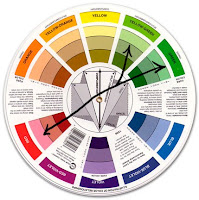Previous step White to Color | Beginning A Poppy of a Tutorial
Again with my painting I am making sure I have the word "water" embedded in my head. Water is the only thing that can help me make the shadows fit my work. I say my work because some people prefer harsh line and heavy shadow...and it looks beautiful! But I'm usually all about the softness, so I like to blend my shadows out into the mid-tones.
Here you can see clearly that my light is coming from the slight lower right hand side of my painting. To be honest, this is not what I intended for my piece. I was thinking more spring or light and airy, but she's obviously not that fairy today. It's a bit darker, but I'll run with it. Great example to show you how the choice in light direction (shadow placement) can determine the feel of your piece. Dramatic lighting calls for dramatic character or emotion. Soft and full of light reminds people of flying kites and picnics. I could go on and on. But I think you understand my point.
Tip: To blend out your shadows, lay down your 1 part painting and 1 part water mixed purple (remember, I use Dioxazine Violet), but be sure to bring water over to it instantly to lighten if you have too much purple. Sometimes you just don't know until you get it on the paper. You can also always dab your brush lightly on your paper towel. Then push the paint towards your mid-tone/highlight area all the while drying your brush on the paper towel, going back, picking up paint by pulling, drying on paper towel, and repeat until it's blended. It's a very dry brush approach to blending. If it's too dry and starting to streak then moisten your brush and pull whatever paint is there, blending it into the mid-tone/highlight. Read this again slowly, you'll get it.
Some areas call for a slightly harsher shadow line. The closer your object/part is to the light, the sharper the shadow. The further away, the softer. I usually keep my faces a good distance away from the strong light sources in my work, unless I need a dramatic effect. The reason is I really love soft classical looking faces. I find the strong light to work best by the arms or torso. I may even do it now without knowing it since I used to always choose to do it in the past.
The opposite of add is subtract, so for sharper shadows I am going to use less water. But that doesn't mean I'm going to have more paint to one part water. I'm going to leave the mixed paint I had for the face area the same. The difference is, once I apply it where I want it, I'm going to dab my brush on my paper towel and go back to pick up any extra paint I don't want. This comes to preference and what kind of shadow you want. If you want to blend, blend, if you want the sharper shadow, leave more paint and let it dry.
The blending also works for sharp shadows that are distancing away, like the shadow her arm is casting on her skirt. I paint the shadow's sharp edge with a brush filled with paint, then clean out my brush, dab dry, come to where I laid my paint down, and pulled it away from the light. This leaves a sharp crisp line where the shadow is closest to the light, but softens as it disappears away.
Tip: Adding extra water (like when I added some after cleaning out the brush) helps make the crisp line once it dries. So any time you want a crisp watercolor line, just add water to that area...where the paint is still wet of course, and let it dry.
Have you heard about the salt technique? What about the rubbing alcohol? Hair dryer splatters? Toothbrush spray? Okay, what about paper towel imprints? Okay, well I highly suggest you gather these items up and play on a scrap piece of watercolor paper. They all give awesome textures to your paint, and who doesn't love texture?! What I most love about watercolor is I do very little, it does all of the work for me.
The most common is the salt technique. I used it on my stone wall. I like using salt in grassy areas, sky, and stone. What I did was apply my purple paint, (darker colors work better) and once it began to seep into my paper I took a pinch of salt (any kind should do, but I used table salt), and lightly sprinkled it on top. Then I let it dry. Once it was dry I gently rubbed off the salt.
Tip: I suggest not painting over the salt, you can, but your effect will not be as strong as you might have hoped. You can hair dryer it, just be sure the hair dryer is at least 6 inches away from your paper.
Okay, so now you've added all of your shadows. You can choose to build them up here at this stage, or down the road. I personally do things in several stages, then repeat those stages until I get the depth of color/shadow/tone that I'm hoping for. But nonetheless, don't let the purple skin throw you. Next I will show you how to finish of the skin. Sometimes having a subject that looks half dead doesn't really motivate you to reach that finish line.
Next, skin tones!!!





































